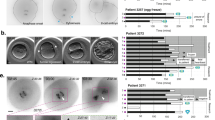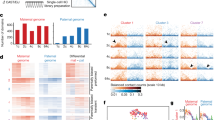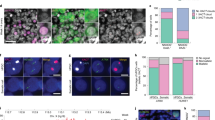Abstract
In somatic cells of female mammals one of the two X chromosomes is genetically inactive and heterochromatic, resulting in dosage compensation for X-linked genes1–3. In marsupials the paternally derived X chromosome is preferentially inactivated. In eutherian mammals, although either X chromosome can be inactivated at random in somatic cells, preferential inactivation of the paternally derived X chromosome has been demonstrated cytologically in mouse and rat yolk sac5,6 and mouse chorion5 and biochemically in mouse yolk sac7, chorionic ectoderm8 and trophoblast. In mouse yolk sac the non-random element has been shown both biochemically7 and cytologically9 to be confined to the endoderm layer in which there is almost total paternal X-chromosome inactivation. We have therefore looked at X-chromosome activity in the separated yolk sac layers of diploid parthenogenetic mouse embryos in which both X chromosomes are maternally derived. Kaufman et al.10 have demonstrated X inactivation in somatic cells of diploid parthenogenetic embryos, and we have used a modification of Kanda's method11, which renders the presumptive inactive X dark staining, to reveal an inactive X chromosome in both endoderm and mesoderm layers of separated yolk sacs from parthenogenones. Thus even in tissues in which there is normally total non-random paternal X inactivation, in the absence of a paternally derived X chromosome a maternally derived X can be inactivated.
This is a preview of subscription content, access via your institution
Access options
Subscribe to this journal
Receive 51 print issues and online access
$199.00 per year
only $3.90 per issue
Buy this article
- Purchase on Springer Link
- Instant access to full article PDF
Prices may be subject to local taxes which are calculated during checkout
Similar content being viewed by others
References
Lyon, M. F. A. Rev. Genet. 2, 31–52 (1968); Biol. Rev. 47, 1–35 (1972); Proc. R.Soc. B187, 243–268 (1974).
Eicher, E. M. Adv. Genet. 15, 175–259 (1970).
Gartler, S. M. & Andina, R. J. Adv. hum. Genet. 7, 99–140 (1976).
Cooper, D. W. et al. in Isozymes III: Developmental Biology (ed. Market, L. C.) 559 (Academic, New York, 1975).
Takagi, N. & Sasaki, M. Nature 256, 640–642 (1975).
Wake, N. et al. Nature 262, 580–581 (1976).
West, J. D. et al., Cell 12, 873–882 (1977).
Frels et al. Devl Genet. 123–132 (1979).
Rastan, S. (in preparation).
Kaufman, M. H. et al. Nature 271, 547–549 (1978).
Kanda, N. Expl Cell Res. 80, 463–467 (1973).
Kanda, N. & Yosida, T. H. Cytogenet. Cell Genet. 23, 12–22 (1979).
Cattanach, B. M. Cytogenetics 10, 318–337 (1971).
Kaufman, M. H., Barton, S. C. & Surani, M. A. H. Nature 265, 53–55 (1977).
Levak-Svajger, B., Svajger, A. & Skreb, N. Experientia 25, 1311–1312 (1969).
Cooper, D. W. Nature 230, 292–294 (1971).
Brown, S. W. & Chandra, H. S. Proc. natn. Acad. Sci. U.S.A. 70, 195–199 (1973).
Gardner, R. L. & Papaioannou, V. in The Early Development of Mammals 107–132 (Cambridge University Press, London, 1975).
Lyon, M. F. in Reproduction and Evolution, Proc. 4th Symp. comp. Biol. Reprod. (Australian Academy of Science 1977).
Takagi, N., Wake, N. & Sasaki, M. Cytogenet. Cell Genet. 20, 240–248 (1978).
Hoppe, P. C. & Illmensee, K. Proc. natn. Acad. Sci. U.S.A. 74, 5657–5661 (1977).
Author information
Authors and Affiliations
Rights and permissions
About this article
Cite this article
Rastan, S., Kaufman, M., Handyside, A. et al. X-chromosome inactivation in extra-embryonic membranes of diploid parthenogenetic mouse embryos demonstrated by differential staining. Nature 288, 172–173 (1980). https://doi.org/10.1038/288172a0
Received:
Accepted:
Issue Date:
DOI: https://doi.org/10.1038/288172a0
This article is cited by
-
Differentiation-dependent requirement of Tsix long non-coding RNA in imprinted X-chromosome inactivation
Nature Communications (2014)
-
Reactivation of the inactive X chromosome in development and reprogramming
Cellular and Molecular Life Sciences (2013)
-
Genetic and parent-of-origin influences on X chromosome choice in Xce heterozygous mice
Mammalian Genome (2005)
-
X-chromosome inactivation occurs at different times in different tissues of the post-implantation mouse embryo
Nature Genetics (1993)
Comments
By submitting a comment you agree to abide by our Terms and Community Guidelines. If you find something abusive or that does not comply with our terms or guidelines please flag it as inappropriate.



